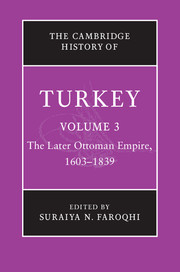Book contents
- Frontmatter
- PART I BACKGROUND
- PART II AN EMPIRE IN TRANSITION
- PART III THE CENTRE AND THE PROVINCES
- PART IV SOCIAL, RELIGIOUS AND POLITICAL GROUPS
- PART V MAKING A LIVING
- PART VI CULTURE AND THE ARTS
- 18 The Ottoman musical tradition
- 19 Arts and architecture
- 20 Ottoman literature
- Glossary
- Bibliography
- Index
- References
19 - Arts and architecture
from PART VI - CULTURE AND THE ARTS
Published online by Cambridge University Press: 28 March 2008
- Frontmatter
- PART I BACKGROUND
- PART II AN EMPIRE IN TRANSITION
- PART III THE CENTRE AND THE PROVINCES
- PART IV SOCIAL, RELIGIOUS AND POLITICAL GROUPS
- PART V MAKING A LIVING
- PART VI CULTURE AND THE ARTS
- 18 The Ottoman musical tradition
- 19 Arts and architecture
- 20 Ottoman literature
- Glossary
- Bibliography
- Index
- References
Summary
Painting in the provinces and in the capital
A provincial perspective: patronage and subject matter in Baghdad
In the Ottoman lands before the mid-nineteenth century, miniature painting was the principal site at which the heroic deeds of sultans, as well as lesser human beings and even landscapes, could be depicted; it was patronised by the sultan’s court first and foremost. Many of the surviving manuscripts were commissioned either by the rulers or by members of their immediate circles. Provincial schools of painting were rare, although this impression may in part be due to accidents of survival.
In the early seventeenth century, miniature painting flourished once again in Baghdad, where this art had a long and distinguished pre-Ottoman history. This was due to the patronage of locally established Mevlevî dervishes, who mainly commissioned illustrated sufi biographies. This revitalisation of Baghdad painting also was due to an ambitious patron, the governor Hasan Pasa (in office 1598–1603), son of the illustrious grand vizier Sokollu Mehmed and a renowned Mevlevî himself, who extended his protection over several dervish lodges. Hasan Pasa’s aspiring and resourceful patronage of the arts was blamed for inviting comparison with that of his sultan, as the governor ordered a variety of costly objects, including a silver throne decorated with fruit trees and flowers. Among the manuscripts illustrated during his tenure in Baghdad there was the Câmîü’s-siyer, a history of Islamic prophets, caliphs and kings, which included a miniature showing Mevlânâ Celâleddîn Rûmî’s fateful meeting with Molla Şemseddîn Tebrîzî, which was to make a scholar from the central Anatolian town of Konya into a world-famous mystic and poet (Fig. 19.1).
- Type
- Chapter
- Information
- The Cambridge History of Turkey , pp. 408 - 480Publisher: Cambridge University PressPrint publication year: 2006
References
- 4
- Cited by

